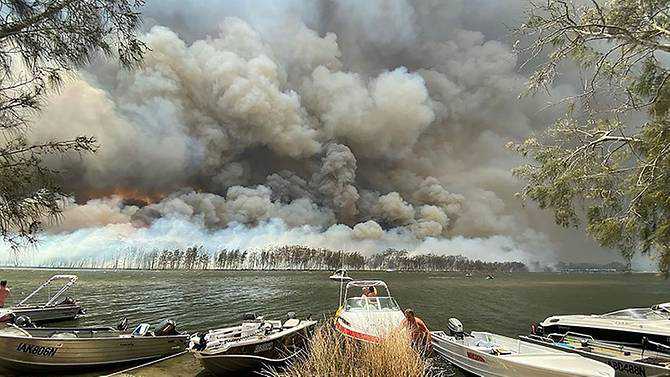Twice the size of Belgium: The scale of Australia's bushfire disaster
05 January, 2020

Skies turned black and ash rained down as fires raged across southeastern Australia on Saturday (Jan 4), threatening power supplies to major cities and prompting the call-up of 3,000 military reservists.
The scale of Australia's unprecedented months-long bushfire crisis has shocked not just locals but the world.
More than 60,000 sq km have been burnt across the country - an area roughly twice the size of Belgium.
In comparison, close to 25,000 sq km of land was burnt in August in the Amazon, the world's biggest rainforest. Almost 8,000 sq km were burnt in California in 2018 in one of the US state's worst-ever wildfire seasons.
"We're in uncharted territory," New South Wales state Premier Gladys Berejiklian said.
"We can't pretend that this is something that we have experienced before. It's not," she said.
"Several townships who never ever experienced a threat of bushfire were at threat of being completely wiped out."
Since late September, 23 people have died - 17 from the most populous state New South Wales - with more than 1,500 homes have been damaged.
The latest fatalities were in Kangaroo Island - a tourist haven southwest of Adelaide - when two people were trapped in a car overrun by flames on Friday.
The death toll for Australia's wildlife is estimated to have hit 480 million in just New South Wales alone, according to a University of Sydney study. Experts fear the loss of animal life could be much higher than the estimates.
Strong winds and high temperatures continued to fuel hundreds of fires and cause chaos.
Bushfires took out two substations and transmission lines, prompting authorities in New South Wales to warn that an area home to almost eight million people and the nation's largest city Sydney could experience rolling blackouts.
RECORD TEMPERATURES
Temperature records were smashed, and gale-force winds pounded fire-stricken coastal communities in the two most populous states New South Wales and Victoria.
A state of emergency had been declared across much of the heavily populated southeast and more than 100,000 people were told to leave their homes across three states.
Thousands heeded that call on Friday, abandoning summer holidays and piling into cars that clogged the highways linking southeastern coastal towns with the relative safety of Sydney or larger towns.
Several emergency warnings were issued, and there were fears that one blaze southwest of Sydney could reach the city's outskirts.
Sydney recorded its highest-ever temperature of 48.9 degrees Celsius in the western suburb of Penrith, and the nation's capital Canberra hit 44 degrees Celsius, also an all-time record, a Bureau of Meteorology spokesman said.
Thousands of volunteer firefighters battled the infernos as some residents stayed behind to defend their homes.
Just outside the seaside town of Batemans Bay, a four-hour drive south of Sydney, locals joined forces with firefighters to tackle the blazes.
The only activity in the usually bustling tourist hotspot was at an evacuation centre, where hundreds of locals forced from their homes were sheltering on an open field in tents and caravans.
Mick Cummins, 57, and his wife fled to the evacuation centre when fire ripped through their rural town on New Year's Eve.
"We said this is too tough for us, let's get out. We went to the beach and then hellfire came over the hill," he told AFP.
"I was here in the '94 fires. I thought that was bad. That was just a barbeque" in comparison, he said.
Australia's capital Canberra was ranked as the city with the poorest air quality in the world on Sunday by Air Visual, an independent online air quality index monitor, amid a severe haze caused by the fires.
Galleries and other buildings were closed safeguard public health.
In Cooma in inland southern New South Wales, the fire crisis turned into a flood disaster when a large tower carrying 4.5 million litres of water swept away cars and filled homes with mud.
"First bushfire and now flood, back-to-back disasters," a shaken resident who asked not to be named told AFP.
Source: www.channelnewsasia.com
TAG(s):
